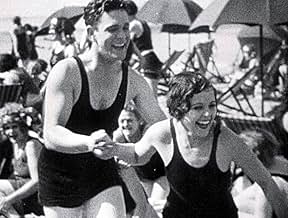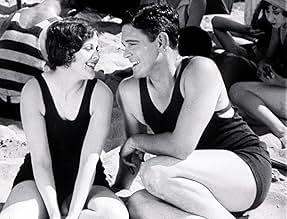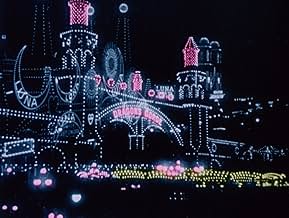VALUTAZIONE IMDb
7,7/10
2724
LA TUA VALUTAZIONE
Aggiungi una trama nella tua linguaTwo lonely people in the big city meet and enjoy the thrills of an amusement park, only to lose each other in the crowd after spending a great day together. Will they ever see each other aga... Leggi tuttoTwo lonely people in the big city meet and enjoy the thrills of an amusement park, only to lose each other in the crowd after spending a great day together. Will they ever see each other again?Two lonely people in the big city meet and enjoy the thrills of an amusement park, only to lose each other in the crowd after spending a great day together. Will they ever see each other again?
- Premi
- 1 vittoria in totale
Gusztáv Pártos
- Romantic Gentleman
- (as Gustav Partos)
Henry Armetta
- Ferris wheel guy
- (non citato nei titoli originali)
Edgar Dearing
- Cop
- (non citato nei titoli originali)
Louise Emmons
- Telephone Caller
- (non citato nei titoli originali)
Fred Esmelton
- Swami
- (non citato nei titoli originali)
Jack Raymond
- Barker
- (non citato nei titoli originali)
Churchill Ross
- Telephone Caller
- (non citato nei titoli originali)
Trama
Lo sapevi?
- QuizIt was one of the first motion pictures to have sound and a couple of talking scenes. It was released in both silent and monaural versions. Some scenes in existing original prints of the film are colored with stencils.
- Versioni alternativeProduced in both sound and silent versions. The sound version was 6,785 feet in length, and the silent version was 6,193 feet.
- ConnessioniFeatured in Fejezetek a film történetéböl: Az amerikai film kezdetei (1989)
- Colonne sonoreAlways
(uncredited)
Written by Irving Berlin
[Played by dance orchestra at ballroom]
Sung by Nick Lucas
[on Brunswick recording played in last scene]
Recensione in evidenza
Lonesome is like the much more charming, if slightly less ambitious (and at the very end a bit too cute) cousin of Sunrise. It's appeal is in its simplicity, but where Sunrise was about a couple breaking apart and coming back together, this is much more streamlined and less tragic (though it does go for some tragic beats in the last twenty minutes of its slim 70-minute run-time): boy is lonely, girl is lonely, both work working-class jobs (factory/phone operator, what else in New York city in 1928?), they both decide separately after their (so-called!) friends go off on their own adventures to go to the beach and amusement park - is it Coney Island? I can't imagine it being anywhere else - and boy and girl meet as the boy tries to show off doing games. And that's it, that's the movie, and why it stands out (and got a sort-of restoration and Criterion treatment) is its presentation by its director.
I don't know much about Pal (Paul) Fejos except that he directed silent films and somewhat into the 1930's, and then sort of faded away into obscurity. It's a shame since a film like Lonesome shows his talents clearly: he has a keen sense of editing and that way that silent filmmakers sometimes had to super-impose images (perhaps a chip off the Abel Gance block perhaps, but not as ambitious), in particular when he's setting up the hustle/bustle of the city and then later in the film when things get more harrowing with the characters. That is to say when, inevitably, the main conflict is that they are separated in that great sea of people that makes up a massive crowd in a city (where, as the man, Jim, notes at one point, is so strange that you're surrounded by so many but still feel so alone).
The charm in the film comes in how the couple on screen - Barbara Kent and Glenn Tryon - are together; they're kind of like if you had one of those romantic "leads" in those really early Marx brothers movies, only they don't sing and the man is funny in that amusing- lightly- sarcastic way (i.e. bragging about his "six acres on Wall street" at first, which we and the girl knows isn't true, but it's fun to play along). Actually, speaking of that, this is an experimental film at heart for a number of reasons. It appears at first to be a silent film, and for 90% of it it surely is, and is shot like one with that film speed we associate with silent cinema on the whole (that kind of slightly-sped-up speed where its rhythm is distinctly of its cameras and era), and we know this because 10% of the film, more or less, is a *sound* film. No, really, we suddenly move from what is the obvious fluid camera style and wide shots of the crowds and intensity that comes with a camera that moves freely to what is clearly static shots in a studio so the actors are right under a microphone... and the acting is just as static.
That's not totally fair; this is considered, at least according to the trivia, one of the very first films to ever incorporate sound. On that level it's certainly extraordinary and important, but the problem is that it becomes jarring with the rest of the film which is shot with such passion and excitement (it's also frankly weird to hear the actor's speaking voices, whereas before, like I do with a lot of silent movies, I can think of my own voices for the actors that do not sound so... stilted). One of the sound scenes is also one where I wasn't sure if a cop was being sarcastic or not; our man Jim has been taken away by the cops after a roller-coaster ride where Mary, the girl, fainted and had to be taken away but Jim got separated and got rough with a cop. For a moment it seems like he'll be put away, but Jim pours his heart out (with some, I'm sorry, cringe-inducing lines), and the cop's reaction is hard to read since it sounds totally "pfft yeah right"... but then they let him go. Very strange.
But these aren't major complaints for a film that has so much to offer outside of those things. This is a movie that's joy is in its purity, that it's about these two people and how they meet and suddenly all of the usual problems of their everyday lives - the work, the drudgery, the intensity of being around so many people getting on/off the subways or being in the traffic - can float away since they have one another. And there are some moments of experimentation that do work, mostly involving (also, again, a touch of daring with Fejos) color: there's tinted scenes here, which isn't unusual for a silent film, but here it's how the colors are used, over the amusement park scenes to illuminate the lights at night, the performers in the park, the vibrancy that the night off a beach in the city brings.
There are so many moments of rich filmmaking, so much hope that this couple is able to inspire in a short amount of time, and because of the simplicity we're able to invest ourselves into their bond as it gets closer (maybe a little *too* quick, one might want to argue, falling in love within a day), that one can almost forgive a cutesy ending. Almost.
I don't know much about Pal (Paul) Fejos except that he directed silent films and somewhat into the 1930's, and then sort of faded away into obscurity. It's a shame since a film like Lonesome shows his talents clearly: he has a keen sense of editing and that way that silent filmmakers sometimes had to super-impose images (perhaps a chip off the Abel Gance block perhaps, but not as ambitious), in particular when he's setting up the hustle/bustle of the city and then later in the film when things get more harrowing with the characters. That is to say when, inevitably, the main conflict is that they are separated in that great sea of people that makes up a massive crowd in a city (where, as the man, Jim, notes at one point, is so strange that you're surrounded by so many but still feel so alone).
The charm in the film comes in how the couple on screen - Barbara Kent and Glenn Tryon - are together; they're kind of like if you had one of those romantic "leads" in those really early Marx brothers movies, only they don't sing and the man is funny in that amusing- lightly- sarcastic way (i.e. bragging about his "six acres on Wall street" at first, which we and the girl knows isn't true, but it's fun to play along). Actually, speaking of that, this is an experimental film at heart for a number of reasons. It appears at first to be a silent film, and for 90% of it it surely is, and is shot like one with that film speed we associate with silent cinema on the whole (that kind of slightly-sped-up speed where its rhythm is distinctly of its cameras and era), and we know this because 10% of the film, more or less, is a *sound* film. No, really, we suddenly move from what is the obvious fluid camera style and wide shots of the crowds and intensity that comes with a camera that moves freely to what is clearly static shots in a studio so the actors are right under a microphone... and the acting is just as static.
That's not totally fair; this is considered, at least according to the trivia, one of the very first films to ever incorporate sound. On that level it's certainly extraordinary and important, but the problem is that it becomes jarring with the rest of the film which is shot with such passion and excitement (it's also frankly weird to hear the actor's speaking voices, whereas before, like I do with a lot of silent movies, I can think of my own voices for the actors that do not sound so... stilted). One of the sound scenes is also one where I wasn't sure if a cop was being sarcastic or not; our man Jim has been taken away by the cops after a roller-coaster ride where Mary, the girl, fainted and had to be taken away but Jim got separated and got rough with a cop. For a moment it seems like he'll be put away, but Jim pours his heart out (with some, I'm sorry, cringe-inducing lines), and the cop's reaction is hard to read since it sounds totally "pfft yeah right"... but then they let him go. Very strange.
But these aren't major complaints for a film that has so much to offer outside of those things. This is a movie that's joy is in its purity, that it's about these two people and how they meet and suddenly all of the usual problems of their everyday lives - the work, the drudgery, the intensity of being around so many people getting on/off the subways or being in the traffic - can float away since they have one another. And there are some moments of experimentation that do work, mostly involving (also, again, a touch of daring with Fejos) color: there's tinted scenes here, which isn't unusual for a silent film, but here it's how the colors are used, over the amusement park scenes to illuminate the lights at night, the performers in the park, the vibrancy that the night off a beach in the city brings.
There are so many moments of rich filmmaking, so much hope that this couple is able to inspire in a short amount of time, and because of the simplicity we're able to invest ourselves into their bond as it gets closer (maybe a little *too* quick, one might want to argue, falling in love within a day), that one can almost forgive a cutesy ending. Almost.
- Quinoa1984
- 28 ago 2017
- Permalink
I più visti
Accedi per valutare e creare un elenco di titoli salvati per ottenere consigli personalizzati
- How long is Lonesome?Powered by Alexa
Dettagli
- Tempo di esecuzione1 ora 9 minuti
- Mix di suoni
- Proporzioni
- 1.19:1
Contribuisci a questa pagina
Suggerisci una modifica o aggiungi i contenuti mancanti

Divario superiore
By what name was Primo amore (1928) officially released in India in English?
Rispondi





























